
As in the boudin from Louisiana, the kielbasa from Poland, and the saucisse de Toulouse from, well, Toulouse, everybody knows sausage can be from a place, but can it be about a place? I never really thought about it until I ate some cheese.
The cheese I ate had a rind rubbed with coffee and lavender. At first glance the combination seemed curious, I figured it fit in with today's culinary trend of pairing disperate flavors to create new profiles, but I was wrong, the resulting palette was very familiar.
Coffeehouse.
The penultimate coffeehouse experience: It's cold outside, the storefront has fogged up windows, walk in and you are greeted by a rush of humidity and the aroma of coffee, cinnamon and something hippie. Good hippie. And as I tasted the cheese, I realized that 'something hippie' was lavender.
My standard for coffeehouses was set in the late 80's at the King Ave. Coffeehouse in Columbus. It had it all: a bottomless cup, light vegetarian fare, and a bead store off to one side. It's where I learned to drink coffee, It's where felt I could be anything I imagined.
A great memory, but a sausage? Sure why not.

Coffee. I started with brewed espresso (too weak), and I tasted a sprinkle of a fancy-pants instant (too nasty). I settled on a finely ground French roast. For that authentic DIY feel, you could roast your own,but for this project, I used store bought.

Lavender. I found some buds at The Spice House, then pulverized them to a powder.
Let's go to the boards:
1000g Meat. Pork, duck, and/or up to 20% pork fat.
18g Salt
5g French roast coffee beans, finely ground
3g Black pepper
2g lavender, finely ground
pinch of cayenne and cinnamon
50g milk powder (optional)
100ml water (or 85ml water and 15ml vodka)
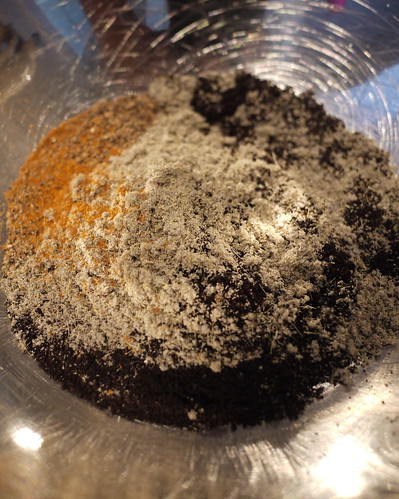
Dice up the meats for grinding. The first time I made it with duck, but pork works very nicely. If using duck, you should add some fat.
After grinding, place meats into chilled bowl and beat in spices, milk powder and liquid. Continue beating to achieve a nice paste. stuff into sheep casings, or roll in plastic.
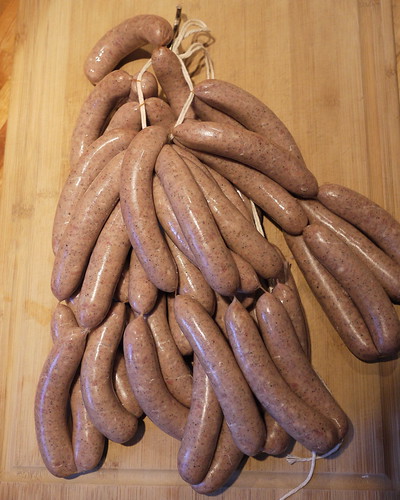
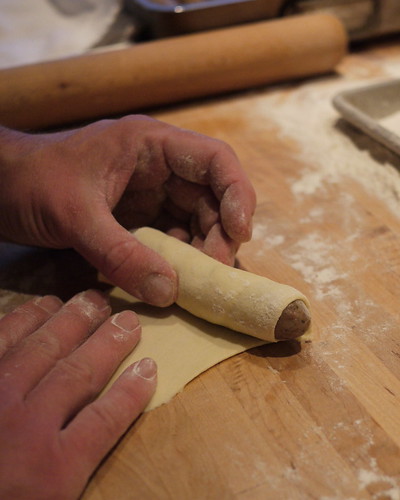
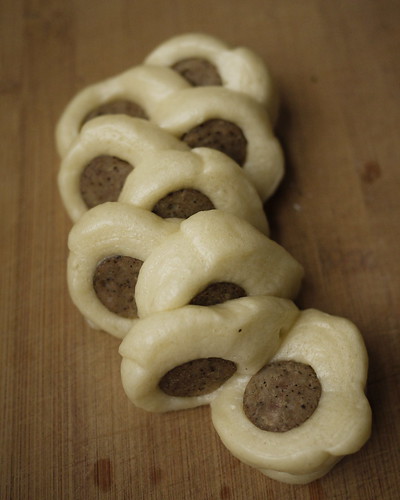
Sausage about place. What do you think? At least it tastes good.
Cheers.
23 February, 2012
Coffeehouse hot link
15 March, 2010
The Ultimate Breakfast Sausage Recipe
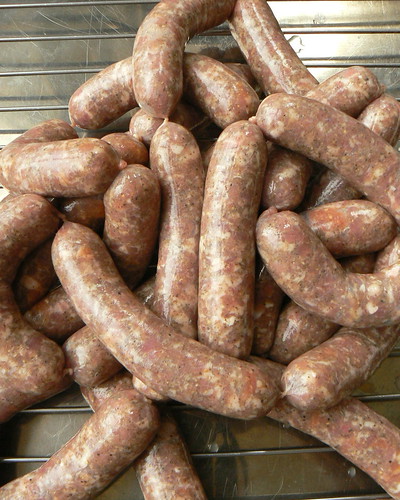
Savory Breakfast Sausage Recipe.
After several weeks of research, thirteen pounds of pork shoulder, numerous taste tests, I collated the comments (i.e. what's that flavor?), tabulated the results, and today I present to you the Ultimate Breakfast Sausage Recipe.
I sent myself on this quest, after longtime reader, George from Ohio, wrote for a recipe. I felt bad (and never responded) because I did not have an answer. Well George, this one's for you, The Ultimate Breakfast Sausage recipe.
[BEEP BEEP] Wait, stop the Dictaphone, I'm getting a message across the Telex. It's the Beard Foundation.
[CLICKING NOISES, THE PHONE RINGS]
Yes, yes I understand.....But I have documentation showing the decline of American Cuisine starting in 1896....Uh-huh, why yes there was a distinct American cuisine that started with the earliest settlers, but this is about a truly American sausage, and I have discovered....
[INDISTINCT MUMBLING]
Ok I will tell them.
[THE PHONE RINGS AGAIN, IT CONTINUES TO RING]
Sorry about the interruption, it has been brought to my attention, that I do not have the Ultimate Breakfast Sausage Recipe, it actually rates only fifth or sixth...out of seven.

When I started my search the first thing I did was scratch the word "Breakfast" and replaced it "Country." We have been making Country Sausage in America for centuries. In his book Cutting-up in the Kitchen, Merle Ellis* decribes Country style sausage with sage. He tells how his grandma would stuff the sausage mixture into 3 x 12" muslin bags called 'pokes," then simply cut rounds as needed for breakfast. Jerry Predika's The Sausage-Making Cookbook, lists nearly thirty recipes for country or farmer's sausage. But the oldest recipe I found was in Mary Randolph's The Virgina House-Wife. First published in 1824, it's America's first cookbook. Randolph's recipe, found on page 66, calls for salt, pepper and sage. She notes that "(The) Sausages are excellent made into cakes and fried." Let's start there.
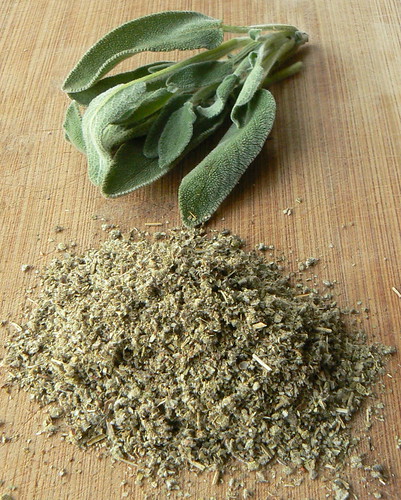
Old Sage
Just like many foodies before me, I have chortled at the notion of using dried herbs. Fresh is better and with the convience of modern groceries (and gardening) I can get a variety of fresh herbs. But wait, did I just pay three bucks for an ounce of "fresh" sage? Yeouch. I decided once and for all to compare fresh to dried, and I have concluded that dried is fine for sausage. For my tastes using 1/2 the measurement of dried sage for fresh is good. So, am I buying dried sage? No, I did for this project, but I grow my own. Do I carefully harvest and dry sage leaves? No...
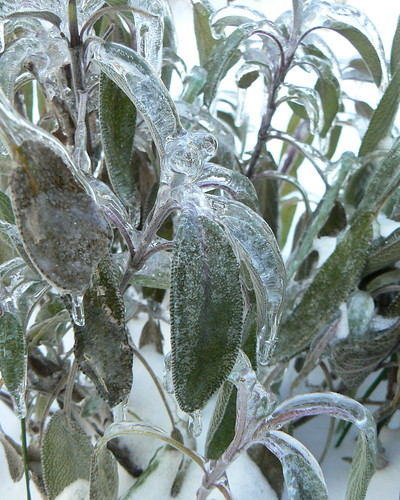
I just grab whatever I can find in the snow and go with it. Growing sage is pretty easy, it's a perennial(it comes back year after year) and as you can see you can grab leaves from it anytime.
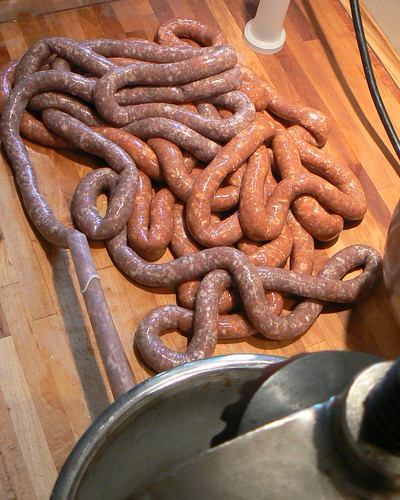
With Randolph's recipe in hand I made some sausage. Was it the Ultimate Breakfast Sausage? Not really. I started thinking about the flavors I wanted, I asked my wife (Bonne Femme), what she thought should go in it, and here's the recipe we finally settled on for the Ultimate Breakfast Sausage:
Savory Breakfast Sausage
1350g/3lbs Pork shoulder ground fine
20g/ 3tsp Salt
15g/ 1T Black peppercorns
18g/ 1/2c Dry rubbed sage
6g/ 1T Whole coriander
60g/2oz/ 1/4c Maple Syrup
120g/4oz/1/2c Water
Finely grind the spices with the salt and mix well into the ground pork. Beat in the maple syrup and water. Continue to stir until the mixture comes together. Stuff into sheep casings or form into 1 pound logs (Pokes). The logs can be wrapped and frozen then later sliced as needed. Fry until pink, do not overcook.
Here are a few additions I tried along the way:
Winter Savory. Another easy to grow perennial, it's flavor is a combination of Rosemary, thyme and mint. But be careful, this stuff is strong, no more than a gram per pound.
Fenugreek seeds. Ever since I read that the extract of this seed is used in maple flavoring, I wanted to use it. While the aroma is very 'mapley' it doesn't come through as well as actual syrup. This spice is an essential ingredient in many curries. It's a form of clover (Greek hay), I might try to grow it this year. In the sausage try 2 grams ground per pound.
Kelp powder. Don't tell the vegetarians I'm using kelp in sausage. Bonne Femme got this stuff for the dog, but I'm using it in bread baking. Scientifically it's Laminaria digitata, a form of brown seaweed. It's known as a superfood and it's loaded with iodine. I tried it in sausage because it enhances the umami, or as the pros say, it add some zip. Folks over in Japan have long known that seaweed triggers our taste buds just like monosodium glutamate. I don't really care one way or the other about MSG, but since I didn't have any, and I did have some kelp, I tried it out. It's noticeable, I want to play around with it some more. Try 1/4 teaspoon per pound.

So it's the Ultimate Breakfast Sausage Recipe, right? Well maybe not. While I was working on this project I happend to thumb through John Thorne's Mouth Wide Open: A Cook and His Appetite. In it he states:
"'Ultimate' recipes are something you earn, not find."
Boy if that ain't a sucker punch to the gut. I spend all this time cramming recipes through my "test kitchen" when I realize it's gonna take me a long time to perfect the Ultimate Breakfast Sausage recipe. In the meantime, YOU can make one too. You've got the basics, start with the three ingredients, and then think would what would taste good. Basil? Garlic? Thyme? Make it yours and it's gonna be good. If you have any questions I'm happy to help.

Cheers.
Resources used in this article (Links to WorldCat.org)
*Merle Ellis, I think he's still around, but the seventies and eighties he wrote a syndicated column called "The Butcher." He had a TV show and a catalogue, A true food star. I like his no nonsense approach. One day I wanna be in a movie where I try all his recipes. It's called MAC and Merle.
Try to find Ellis' Great American Meat Book, it pretty interesting.
The Sausage-Making Cookbook by Jerry Predika
The Virgina House-Wife by Mary Randolph, annotated by Karen Hess
About Savory and Sage, The Herbfarm Cookbook by Jerry Traunfeld
About Fenugreek, Cooking with Herbs and Spices by Andi Clevely et AL.
About Seaweed and MSG, The Oxford Companion to Food by Alan Davidson
Mouth Wide Open: A Cook and His Appetite by John Thorne, Matt Lewis Thorne
02 March, 2010
03 March, 2008
Chorizo, chorizo
Chicken chorizo hash for breakfast.
Did you read the previous post where I suggested getting a whole chicken? Did you get one? Did you make stock? Did you stuff the legs with Swiss chard and cheese? Some people may call it an obsession, but I just call it a good habit. I bought another bird, made stock, some "chikin" fingers for the boys, and... What's that? Ma are you comin' to visit? Well I got a chicken breast what should we make?
Around here we love whippin up something good for breakfast. I am particularly partial to any menu with the words huevos and rancheros on it. I figured with the leftover chicken I could whip up some ranch style hash with chorizo.
Chicken Chorizo
720 g (1lb 80z) Chicken cubed
125 g ( 4 oz) Bacon diced
8 g Salt
7 g chile powder*
5 g paprika
3 g black pepper
1 g Mexican oregano
1 clove
Pinch of cinnamon
10 g garlic minced
Vinegar (15 ml) and water (30 ml) as needed
*The chile powder plays the star roll in this sausage so use something good. I had some New Mexico powder and I ground up a guajillo. Check out Penzeys or the Spice House for your chile needs.
This is best started the night before so that the chicken has a chance to marinate. Grind the whole spices in a mill and combine with everything else except the vinegar and water in a large bowl. Rest it in the fridge overnight. The next morning run it through the meat grinder. Stir the ground mixture adding the vinegar and water so that it starts to come together. Fry it up in a pan with some red potatoes, some onion, a poblano pepper and presto! hash. Serve with homemade corn tortillas and poached eggs.
For more chorizo fun, check out this video of Novak and his ode to Chorizo:
Spring is coming.
¡Salud!
31 January, 2008
Duck and Ham: The Final Chapter
Magret Sec (duck prosciutto)
Bacon and Onion Tart
Trout a la Meuniere
Cassoulet
Sticky Date Pudding
Le Petit Déjeuner
Croissants avec:
Jambon et Comté
Pâte d'Amandes
Chocolat
It been a busy couple of weeks here at the hermitage, but we will always take time for food and friends. This past weekend we took the show on the road to celebrate birthdays and to execute the final chapters of Ham Serial and Duck Tale.
 Magret Sec (duck prosciutto)
Magret Sec (duck prosciutto)It embarrasses me to say duck prosciutto. I suppose it's a good name, it succintly describes the flavor and the process, and it certainly has a better ring than dried duck breast, but it's not ham. So I came up with a new name, Magret Sec. It's French for dry duck filet. Sliced thin, the magret does taste a lot like its former namesake, but instead of curing for a year or more, I got mine in about a week.

I dried them for about ten days achieving about a thirty percent reduction in weight. The temperature stayed in the fifties but my humidity dipped as low as forty percent. Well worth the effort. For anyone thinking about curing duck, go for it.
 Bacon and Onion Tart.
Bacon and Onion Tart.Next on the appetizer parade is Bonne Femme, with her signature Bacon and Onion Tart. Her recipe is adapted from the cookbook, Cooking with Master Chefs.


People often ask me: Are you learning anything at culinary school? Oui. On the day we were pan frying fish, Chef talked about a hatchery in Wisconsin that was great place to get fresh trout. Turns out this place is about ten minutes from where we were staying.
Rushing Waters Fisheries was pretty cool and the fish doesn't get any fresher. Since I just wanted a quick and easy appetizer, I pan fried the filets in clarified butter, then finished with a whole butter and lemon sauce served on mixed greens. Stay tuned for an upcoming episode when I cure and cold smoke some filets I brought home.

Oh boy I love this stuff. I wrote about cassoulet last year and I focused on the idea that this dish is a combination of items that come from your pantry and larder (pronounced beer fridge). This version raids the pantry again but I also made a quick trip to Walt's for some lamb.



Remember our crock of canard from two weeks ago? I had to warm the vessel in the oven so that I could wrestle the legs from their larded slumber. I browned them up in a pan along with the sausages and then assembled the whole lot (Beans and ragout too) into the biggest pan I could find.

 Bubble in the oven for several hours, serve with love.
Bubble in the oven for several hours, serve with love.Here are the birthday girl(s) at about 23:30. JJ brought a cheese plate and Chrissy made the sticky plum pudding, shown here with candles and a caramel sauce. Zach discharged his duties expertly, sommeliering his way through the courses with some great wine choices, mostly Côtes du Rhônes, but also some domestic white and Austria red (who knew?) just to mix it up.
With dinner service concluded, time to hit the hay. The kids will be getting up in a few hours and they are going to want breakfast.
et le Jambon?
I am happy to report that the ten day long transformation from leg of pork to country style cured ham was successful. Most of it is still waiting to be made into sandwiches, the bones I saved for lentils, but some of the choicest slices went to Wisconsin last weekend to play the lead role in breakfast,
the ham and cheese croissant.
 I made some chocolate ones and some almond ones too.
I made some chocolate ones and some almond ones too. After breakfast we went outside.
After breakfast we went outside.Good food, good friends, great weekend. Anyone can do this anywhere.
Don't fuss, just cook.
Cheers.
Posted by mac at 23:13 1 comments
Labels: Bacon, Breakfast, Cassoulet, confit, Croissants, duck prosciutto, French Cooking, Ham, Saucissons, Smoking, Travels
30 April, 2007
Waffle Party
Fermented Yeast Waffles

1- 3/4 cups milk
4 oz butter cut up
10 oz (2c) AP Flour
1T sugar
1 tsp salt
1-1/2 tsp (5g) instant yeast
2 large eggs
1 tsp vanilla extract
I melted the butter in the milk over low heat, then allowed to cool to at least 110F (don't wanna scorch the yeast). Meanwhile I combined all the dry ingredients in a large bowl and in another bowl. I lightly beat the eggs with the vanilla. I first added the milk mixture to the dry ingredients using a rubber spatula to keep it smooth then I incorporated the eggs. Covered and refrigerated overnight.
The next morning the batter is nearly over flowing the bowl. I give it a little stir and then put the iron to work. These waffles are unbelievably good. I made one batch with 50 percent whole wheat, also highly recommended. And they freeze really well; make a big batch and save on your Eggo bill. They crisp up in the toaster real nice. One thing these waffles don't do nice is hold in the oven. Eat them right off the griddle. I think quantities listed made about 7 waffles on our little 7 inch iron, I'm not sure, I made a triple batch for the waffle party.
Hey, what's a party without sausage?
First of all, I would like to dispel the impression that making sausage takes a long time. I made 2 pounds of sausage, which was plenty for the 5 adults and 5 children at the party, in 90 minutes, including clean up. If I had not of stuffed it, the time would have even been shorter. I did make a couple of shortcuts with the ingredients, such as using dried sage and powdered ginger; yet still I had a stand up link. Let's go to the boards:
895 g pork shoulder cut into 1 inch cubes
16 g salt
4 g dried sage
2 g ground black pepper
dash garlic powder
26 g (2T) maple syrup
cold water
Combine the dry ingredients with the cubed pork and run it though the grinder with the fine plate. In a measuring cup pour in the maple syrup then add cold water to the 100 ml mark. Using the paddle attachment or a big wooden spoon, stir the sausage mixture adding the water. Continue until the mixture starts to come together about 1 minute. If your are feeling fancy stuff into sheep casings twist into 4 inch lengths.
Notes: S asked for a milder sausage, but next time I might add a pinch (up to 1 gram) of cayenne to balance the sweetness. If you don't like maple syrup, just use 100 ml of water. Make these sausages at least the day before so that the ingredients get a chance to mingle. If you stuff them into casings, let them mingle in the fridge unwrapped (maybe even on a wire rack) so that the skins dry a little.
So anyway it was a nice get together, Sabra brought pomegranate juice and champagne for pimosas, we sat out on the new patty o'furniture (sorry it's a tic), and our morning brunch floated into an afternoon garden party.

photo credit: Josh
By 3:00 we had broken into the vin de hoo-hoo, and were feeling ready for a nosh. In no time, La Bonne Femme, put together and presented her signature dish, the bacon and onion tart.
The brunch wound down around 4. All was left to do on the sleepy Sunday was stretch out and wait for the sun to set. It's not just sausage, it's a lifestyle.
Cheers.
17 April, 2007
Croisssants avec Jambon et Fromage
Amazingly enough, growing up in Columbus we were able to get very good croissants. Of course at the time I didn't think of it as amazing, I just thought of it as something we did sometimes on Saturdays. My dad would go the the French Loaf and pick up some plain ones, some with chocolate and some with almond paste. The croissants were perfect, flakes would crumble into my lap as I pulled them apart. As a nine year old I was evenly split on my preferences: I had to have a chocolate one (Chocolate for breakfast!) but at the same time I could not deny the eye-rolling joy of a plain one crammed with butter and Strawberry jam. These pre-adolescent times gave way to high school and other desires like girls and egg mcmuffins, and the croissant faded into the background.
Fast forward to a few years ago, One day while visiting in CMH, La Bonne Femme, my sister Jeanlouise and I decided we needed to find some ham and cheese croissants for breakfast. We started at Mozart's Bakery (no), the French Loaf (nope), then to La Chatelaine (nada) We gave up and ate crouque-monsiuers. While munching on our sandwiches we discussed making croissants at home. I dismissed the idea as too complicated, while I didn't have first hand knowledge of a recipe, didn't it take several days, and a careful hand to create flaky goodness? I declared that we should leave the pastries to the professionals and we should dedicate ourselves to being the epicures that would find the finest made croissants wherever we went.
My attitude changed on a subsequent CMH gathering. Jeanlouise flew in from DC with a ball of dough in her carry-on. The next day she presented perfect croissants from the oven.
"Did it take a long time?" I asked
"I did it over a couple of days," she responded.
"Was it hard to do?"
She said: "Nah, dude, you just have to fold it a few times. So I did it once before I went to work, then once when a got home, then the same again the next day."
"Huh, cool."
Inspired by this new information, I went to the library and checked out The Bread Bible, by Rose Levy Beranbaum. Using her recipe I have produced croissants several times. While I can't say making them is simple, it's really not that hard, and they are always good.
So, now fast forward to two weekends ago at another family gathering in Columbus. Jeanlouise was not there, but we have found what we were looking for before: The ham and cheese croissant.

 As I savored one of these over sized lovelies, the idea hit me, I could make these at home with the leftover Easter Ham.
As I savored one of these over sized lovelies, the idea hit me, I could make these at home with the leftover Easter Ham.Fast forward to two days ago. They boys got me up at their usual time of 6:21 AM. I got out my ingredients.



I rolled out the dough and cut it into triangles.
 I rolled out each triangle, a little bit of ham, a little bit of cheese...
I rolled out each triangle, a little bit of ham, a little bit of cheese... A little bit of chocolate
A little bit of chocolateRoll em and let em rise.
After about an hour, an egg glaze and into the oven.


A word about the Jambon:
As I mentioned last week and as you can see in the picture today, the ham cured unevenly. A new reader (we will call him Chef G, not to be confused with Uncle J from the AK, who is also a chef, or Un-named Village Official J, who was my co-conspirator in Sausage Mania) commented that is would be very hard to get a complete cure on a ham without injecting it. Well it didn't say anything like that in the cookbook, but I am aware that they use big needles with solution to cure hams commercially. Alas, I wont turn down advice from a professional; I bought a marinate injector and started another ham yesterday. Well see how it turns out.
Cheers.






















